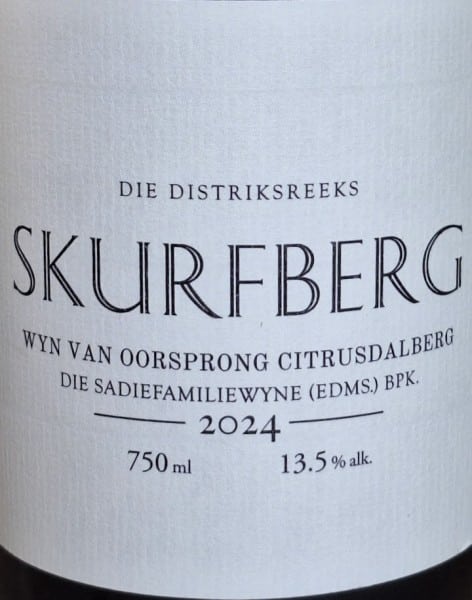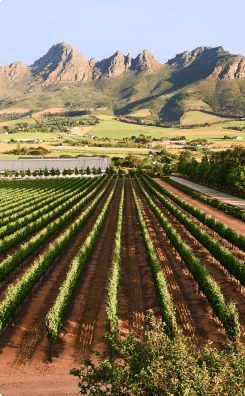Sadie Family Wines District Series new releases
By Christian Eedes, 16 September 2025

11
The Sadie Family Wines District Series were released some time ago. Normally, I would taste them quickly at the cellar, but this year I reviewed them over two evenings – working back and forth, alone and with food, debating them with friends. It was a reminder of just how intellectually demanding these wines are: not all perfect, whatever that means, but consistently attention-grabbing and thought-provoking.
Soldaat 2024
Price: R600
From Piekenierskloof Grenache. 30% whole-bunch fermentation. Matured for 12 months in concrete tanks. Striking aromatics of red berries, floral perfume, fynbos, white pepper and a slight flinty note. The palate has good shape and drive – pure fruit, bright acidity and ultra-fine tannins. Lean and focused – no excess fleshiness. Alc: 13.5%.
CE’s rating: 95/100.
Pofadder 2024
Price: R600
From Swartland Cinsault. 30% whole-bunch fermentation. Matured for 11 months in foudre before a further month in concrete The nose shows red currant, cherry, strawberry and plum alongside fynbos, earth, spice and a touch of rubbery reduction that quickly blows off. The palate is juicy and bright with soft, supple tannins. Open and accessible yet not overly sweet, offering broad appeal without losing authenticity. Alc: 13.5%.
CE’s rating: 93/100.
Treinspoor 2024
Price: R600
From Swartland Tinta Barocca. 30% whole-bunch fermentation. Matured for 11 months in foudre before a further month in concrete. The nose is evocative with notes of dark berries, fig, lavender, fynbos and earth. The palate shows dense fruit, brisk acidity and firm tannins, the finish ultra-dry. Balanced and substantial – compelling rather than nuanced, powerful without being clunky. Alc: 13.5%.
CE’s rating: 94/100.
Sonvang 2024
Price: R600
From a Swartland vineyard co-planted to Alicante Bouschet, Agiorgitiko, Pontac, Bastardo do Castillo, Trincadera, Tinta Barocca, Lledoner Pelut, Grenache Noir, Pinotage, Cinsaut, Counoise and Carignan. Not suitable for review due to cork taint.
Skerpioen 2024
Price: R600
From a Swartland vineyard co-planted to Chenin Blanc and Palamino. Matured for 12 months in cask. A heady, exotic nose with notes of lemon, orange, peach, melon, floral perfume and fynbos. The palate is dense and somewhat atypical – fruit appears sweet-toned and the structure a little flat, despite analysis suggesting otherwise. Already quite forward in its evolution. A curious vintage, not without intrigue. Alc: 13%.
CE’s rating: 93/100.
‘T Voetpad 2024
Not generally available. From a Swartland field blend of Chenin Blanc, Palomino, Muscat d’ Alexandrie and Semillon Blanc and Gris. Matured for 12 months in cask and foudre. The nose is complex with white, green and yellow fruit, fynbos, earth and spice. The palate marries power with restraint – dense fruit matched by punchy acidity, creamy in texture but not excessively so, the finish pithy and dry. Superb balance and extraordinary intricacy. Alc: 14%.
CE’s score: 97/100.
Kokerboom 2024
Price: R600
From Citrusdal Mountain Semillon. Matured for 12 months in cask. Top notes of fynbos and hay before lime, apple and a hint of reduction. The palate shows excellent fruit concentration matched by fresh acidity, the finish long and dry. Rich but equally tightly wound. Alc: 14%.
CE’s rating: 95/100.
Twiswind 2024
Price: R600
From a Swartland vineyard co-planted to Vermentino, Picpoul, Marsanne, Grenache Blanc, Cinsaut Blanc, Palominio, Chenin Blanc, Grillo, Assyrtiko, Verdelho, Clairette Blanche and Semillon. Matured in concrete tank and wooden vats for 11 months. Pretty aromatics of herbs, flowers, lime, lemon and peach. The palate is clean and vital but perhaps a touch simple in comparison to its counterparts – good fruit expression and crisp acidity before a dry finish. Alc: 13.5%.
CE’s rating: 92/100.
Rotsbank 2024
Price: R600
From Swartland Chenin Blanc. Matured for 12 months in cask. The nose opens with waxy, earthy notes before giving way to citrus, peach, pineapple and a touch of honeysuckle. The palate is rich and layered with assertive acidity and a savoury, grippy finish. Powerful, idiosyncratic and firmly structured – demanding at present but should benefit from time in bottle. Alc: 13.5%.
CE’s rating: 95/100.
 Skurfberg 2024
Skurfberg 2024
Price: R600
From Citrusdal Mountain Chenin Blanc. Matured for 12 months in cask. The nose is compelling, showing citrus, peach, earth, fynbos, spice and a touch of flinty reduction. The palate is powerful yet full of energy and life, combining breadth, depth and detail. Fruit is sharply defined, sour-citric acidity lends verve and there’s an intriguing olivaceous twist on the finish. A superb vintage from a remarkable site. Alc: 13.5%.
CE’s rating: 98/100.
Mev. Kirsten 2024
Price: R1,330
From Stellenbosch Chenin Blanc. Matured for 12 months in foudre. From Stellenbosch Chenin Blanc, matured for 12 months in foudre. The nose shows fynbos, lemon, orange, green olive, ginger and spice. The palate is rich and weighty, tempered by tangy acidity that keeps it from becoming excessive. A imposing wine, broad and layered, though perhaps just a touch lacking in drive. Alc: 14%.
CE’s rating: 95/100.
Check out our South African wine ratings database.
Comments
11 comment(s)
Please read our Comments Policy here.







Johan Smuts | 16 September 2025
Hi Christian,
Thx for reviewing the latest vintage of Sadie District series. The various opinions of wine critics and/or experts always provide insightful reading material.
One question your review or rating of the latest Skerpioen vintage differs vastly from many others. Did you find the wine too simple or just not to your liking in reference to the other whites of Eben.
In my opinion i find this wine more ready to drink but in no way is the wine of inferior quality but rather a highly rated wine just ready for consumption earlier.
JS
Christian Eedes | 16 September 2025
Hi Johan, I find the Skerpioen 2024 tasty but a bit of an outlier in terms of how this wine usually shows – much heavier with more tropical fruit in evidence. Miss its usual tightness and salinity.
Timothy Conn | 16 September 2025
Thanks for the write up! Grateful for your thoughtful analysis. Out of curiosity, what type of cork does he use? I’m guessing natural rather than diam due to the taint on the Sonvang? Such a shame. For someone who puts so much effort into the viticulture it must be heartbreaking for the wine to be ruined at the very final step….
Christian Eedes | 16 September 2025
Hi Timothy, All wines under natural cork.
Vian Gericke | 16 September 2025
I find it truly fascinating that critics can both agree and completely disagree to such a large extent when it comes to scoring the same wines. Take the following two wines from this review as examples:
The second highest scored white wine overall in Tim Atkin’s SA report this year was Skerpioen, at 99 points, and it’s one of the lowest scored wines by Christian in this review at 93 points, a substantial 6 point difference.
And then if you look at ‘T Voetpad, which Tim and Christian both scored 97 points, they are in total agreement.
Thought-provoking indeed.
Thapelo Mangope | 16 September 2025
Hi Christian
Cork taint is such a joy thief. TCA on a recent bottling is somewhat peculiar though, methinks.
And to Timothy’s point, it must be vexatious to see a year long hard graft in the vineyards amounting to nothing due to cork taint when there’s alternatives out in the market. Eben should rejig his thinking around closures and perhaps opt for Diams as alternative bullet proof solutions as a few others have done over the past while. When is his next ‘ten year cellar review’ process?
Timothy Conn | 16 September 2025
Or even screwcap! I find it curious how rare it is amongst the kinds of producers featured on this website.
Wessel Strydom | 16 September 2025
Thapelo, I agree 100% with you. Could anyone enlighten this novice why producers don’t opt for Diam instead of natural cork. Is Diam more expensive? Does wine age better with natural cork?
Bernard | 16 September 2025
They are still of the philosophy of natural closure for what is a natural product.
Corks supposedly let wines age better where wines under Diam can sometimes be stagnant.
They compete against top producers like DRC to get the best individually tested corks.
Greg Sherwood | 16 September 2025
Tasted most of the wines again at Cape Wine with Markus Sadie. Your scores are just about right though I might be slightly higher on Skerpioen, being less perturbed by the style shift this vintage – I actually really liked it but did miss the austerity and salinity a bit. Rotsbank 2024 very solid but again, perhaps a shade off the quality and intensity of the 2022 and 2023 for me. Twiswind remains a devisive wine. I have a bottle to review that I’ll drink over 2-3 days to see what happens. But I suspect I’ll land in the 92-94 range. For me, Sonvang Red was very exciting… exotic, energetic, vibrant, fresh, crunchy, concentrated and a little bit wild. Shame your bottle was out of condition. All wines very solid indeed without the power of the 2023 vintage. But then Eben does say that in his vintage overview.
Gareth | 16 September 2025
Nice to see a review of these wines after all, well done and thank you. Bummer about the cork taint on the Sonvang. Actually, Sadie has a very good policy on replacements due to cork taint:
“Foremost wine is a natural produce, and the cork stopper is even more so. Cork is a perfect closure in the world in terms of its ability and memory to take on precisely the expanded shape of the inner neck boreof the bottle. That is the physical marvelous aspect of the cork. At the same token, the cork can also hold chemical compositions and unstable chemical aspects such as 2,4,6-Trichloroanisole (TCA) or 2,4,6-Tribromoanisole (TBA) as well as some organic components, more rarely these days due to the stringent sorting processes. These aspects can lead to the spoilage of the wine. We use individually tested corks to eliminate contamination; however, some of the components might be embedded deeper in the cork, as a cork usually comprises nine years of growing the bark. Irrespective of the efforts, a cork-tainted bottle rarely presents itself.
i) We do replace cork-tainted wines.
ii) The Client needs to within 24 hours notify us of the tainted bottle, and we will arrange for
the bottle to be collected. Please return the bottle with the original cork and the wet side of
the cork inside the bottle for collection.
iii) We will replace the bottle immediately.
iv) The results sometimes take up to a month to come back to us, for we send the bottle back to Portugal for a complete analysis of the wine and the cork.
v) If the wine was found not to hold any off flavours or contaminated aspects, we will present the client with the lab report, and the replacement bottle will be for the client’s account.
vi) Only wines purchased directly from us or our trade partners will be replaced; we cannot participate in the secondary market’s movements and conditions.”
From:
https://thesadiefamily.com/wp-content/uploads/2024/03/The-Sadie-Family-Wines-Pty-Ltd-Policy-on-Replacements.pdf